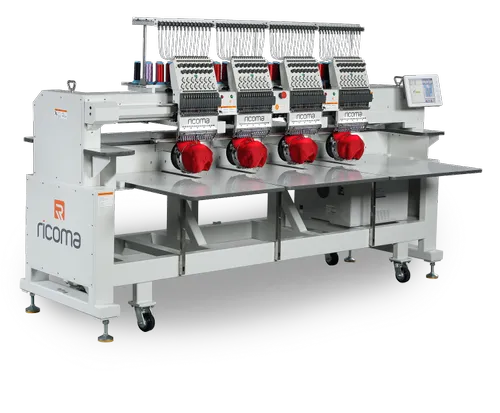Expert Tips for Digitizing Embroidery Designs with Precision
Embroidery is a beautiful blend of art and technology, and at the heart of every stunning embroidered design is a...

Embroidery is a beautiful blend of art and technology, and at the heart of every stunning embroidered design is a well-digitized file. Digitizing embroidery designs is the process of converting artwork into a digital format that embroidery machines can understand and stitch. While it may seem straightforward, achieving precision in digitizing requires skill, attention to detail, and a deep understanding of the craft. Whether you’re a beginner or an experienced digitizer, these expert tips will help you create flawless embroidery designs that stand out.
What is Embroidery Digitizing?
Embroidery digitizing is the process of translating a design—such as a logo, artwork, or text—into a digital file that an embroidery machine can read. This file contains instructions on stitch types, directions, densities, and the order in which the design will be stitched.
Think of it as creating a roadmap for the embroidery machine. Without precise digitizing, even the most beautiful design can end up looking messy or distorted when stitched.
Why Precision in Digitizing Matters
Precision in digitizing ensures:
- Clean and Crisp Designs: Sharp edges, smooth curves, and accurate details.
- Durability: Stitches that hold up over time, even after washing or heavy use.
- Professional Results: A polished look that reflects quality and craftsmanship.
On the other hand, poor digitizing can lead to issues like thread breaks, puckering, or designs that don’t resemble the original artwork.
Expert Tips for Digitizing Embroidery Designs with Precision
1. Start with a High-Quality Image
The foundation of a well-digitized design is a high-quality image. A blurry or low-resolution image will make it difficult to capture the details of your design.
- Use vector files (like .AI or .EPS) if possible, as they are scalable and maintain clarity at any size.
- If you only have a raster image (like .JPEG or .PNG), ensure it’s high-resolution and clean.
2. Choose the Right Digitizing Software
Professional digitizers use specialized software like Wilcom, Pulse, or Hatch. These programs offer advanced tools for precise control over stitch types, densities, and other parameters.
If you’re new to digitizing, consider starting with beginner-friendly software like Embrilliance or InkStitch. These tools provide a good introduction to the process without overwhelming you with complex features.
3. Understand Stitch Types
Different parts of your design will require different stitch types. Here’s a quick overview:
- Satin Stitches: Ideal for text and borders, these stitches create a smooth, shiny finish.
- Fill Stitches: Used for larger areas, these stitches cover space efficiently.
- Running Stitches: Perfect for fine details and outlines.
Choosing the right stitch type for each part of your design is key to achieving a balanced and visually appealing result.
4. Set the Right Stitch Density
Stitch density refers to how closely the stitches are packed together. Too dense, and the design may feel stiff or cause fabric puckering. Too loose, and the fabric may show through, making the design look incomplete.
- For most fabrics, a medium density works well.
- Adjust density based on the fabric type—thicker fabrics can handle higher density, while delicate fabrics require lighter stitching.
5. Use Underlay Stitches Wisely
Underlay stitches are the foundation of your design. They help stabilize the fabric and provide a base for the top stitches.
- Use zigzag underlay for satin stitches.
- Use edge run underlay for fill stitches.
Proper underlay ensures that your design stays in place and looks crisp.
6. Map Out the Stitching Order
The order in which the design is stitched can impact the final result. Generally, you’ll want to stitch the background elements first and then move to the foreground.
- Start with underlay stitches to stabilize the fabric.
- Move on to fill stitches for larger areas.
- Finish with satin stitches for borders and details.
This approach prevents distortion and ensures a clean, professional look.
7. Test and Refine
Once you’ve digitized your design, it’s time to test it. Stitch out the design on a scrap piece of fabric similar to what you’ll be using for the final product.
- Look for issues like thread breaks, misaligned stitches, or areas that don’t look right.
- Make adjustments to the digitized file as needed and test again.
Testing is the only way to catch and fix issues before stitching the final product.
Tips for Perfecting Your Digitizing Skills
1. Simplify Complex Designs
Embroidery has its limitations, and overly complex designs can lose detail when stitched. Simplify your design by:
- Removing tiny text or intricate elements that may not stitch well.
- Combining similar colors to reduce the number of thread changes.
2. Consider the Fabric
Different fabrics behave differently under the needle. For example:
- Stretchy fabrics like spandex require stabilizers to prevent distortion.
- Thick fabrics like denim may need a higher stitch density.
Always take the fabric into account when digitizing your design.
3. Pay Attention to Thread Colors
The right thread colors can make or break your design. Use high-quality embroidery thread and test colors on scrap fabric to ensure they match your design perfectly.
4. Don’t Rush the Process
Digitizing is a skill that takes time to master. Be patient, and don’t be afraid to experiment and learn from your mistakes.
Common Mistakes to Avoid
1. Ignoring Fabric Type
Using the same digitized file for all fabrics can lead to poor results. Always adjust your design based on the fabric you’re working with.
2. Overcomplicating the Design
Less is often more in embroidery. Avoid cramming too many details into your design, as they may not translate well to stitches.
3. Skipping the Test Stitch
Never skip the test stitch. It’s the only way to catch issues before stitching the final product.
4. Using Low-Quality Thread
Cheap thread can break easily and fade over time. Invest in high-quality embroidery thread for the best results.
When to Hire a Professional Digitizer
While digitizing your own designs can be rewarding, there are times when it’s best to leave it to the pros. Consider hiring a professional digitizer if:
- Your design is highly detailed or complex.
- You’re working on a large project with tight deadlines.
- You want to ensure the highest level of quality and precision.
Professional digitizers have the experience and tools to create flawless designs, saving you time and frustration.
Conclusion
Digitizing embroidery designs with precision is both an art and a science. By following these expert tips, you can create clean, professional-looking designs that stand out. Remember to start with a high-quality image, choose the right stitch types, and always test your design before stitching the final product. Mastering Digitizing For Embroidery ensures your creations are flawless and visually stunning every time.
Whether you’re digitizing designs for personal projects or business purposes, mastering this skill will open up a world of creative possibilities. So grab your software, practice, and watch your embroidered designs come to life!




